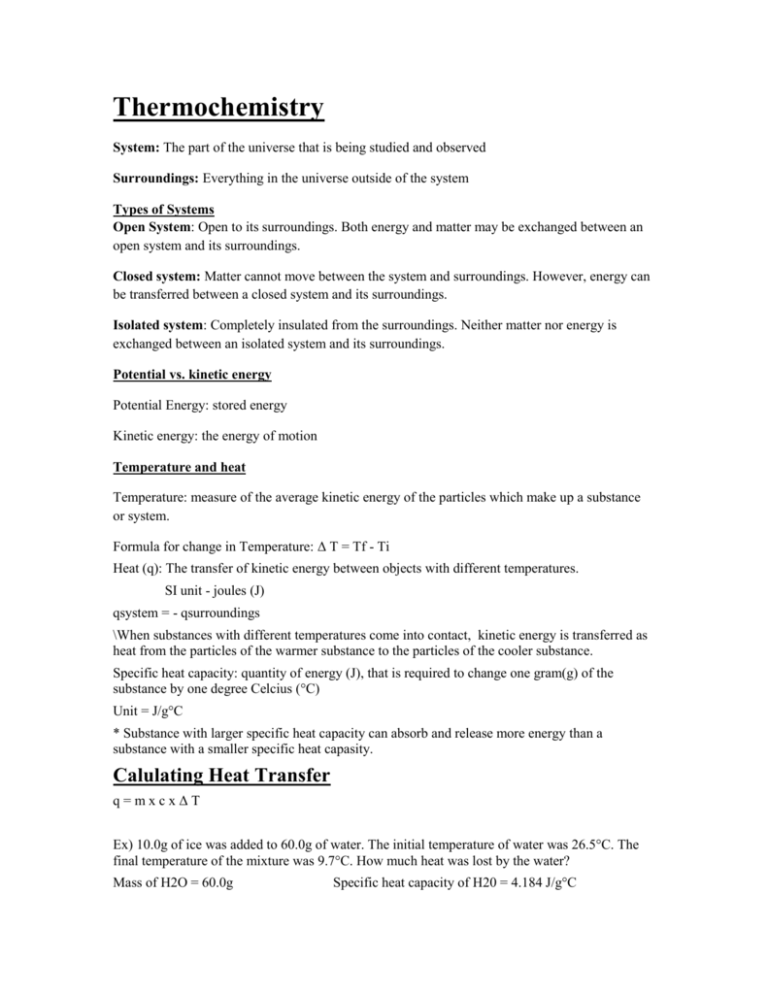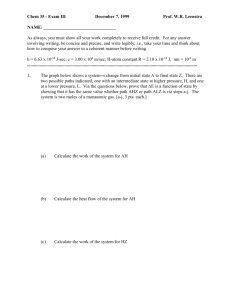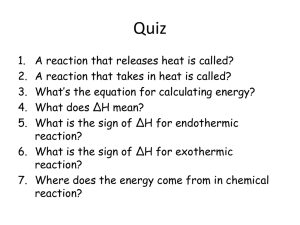Thermochemistry2
advertisement

Thermochemistry System: The part of the universe that is being studied and observed Surroundings: Everything in the universe outside of the system Types of Systems Open System: Open to its surroundings. Both energy and matter may be exchanged between an open system and its surroundings. Closed system: Matter cannot move between the system and surroundings. However, energy can be transferred between a closed system and its surroundings. Isolated system: Completely insulated from the surroundings. Neither matter nor energy is exchanged between an isolated system and its surroundings. Potential vs. kinetic energy Potential Energy: stored energy Kinetic energy: the energy of motion Temperature and heat Temperature: measure of the average kinetic energy of the particles which make up a substance or system. Formula for change in Temperature: Δ T = Tf - Ti Heat (q): The transfer of kinetic energy between objects with different temperatures. SI unit - joules (J) qsystem = - qsurroundings \When substances with different temperatures come into contact, kinetic energy is transferred as heat from the particles of the warmer substance to the particles of the cooler substance. Specific heat capacity: quantity of energy (J), that is required to change one gram(g) of the substance by one degree Celcius (°C) Unit = J/g°C * Substance with larger specific heat capacity can absorb and release more energy than a substance with a smaller specific heat capasity. Calulating Heat Transfer q=mxcxΔT Ex) 10.0g of ice was added to 60.0g of water. The initial temperature of water was 26.5°C. The final temperature of the mixture was 9.7°C. How much heat was lost by the water? Mass of H2O = 60.0g Specific heat capacity of H20 = 4.184 J/g°C Initial Temperature = 26.5°C Δ T = Tf - Ti Final Temperature = 9.7°C Δ T = 9.7°C - 26.5°C = -16.8°C q = mcΔT q = 60.0g x 4.184J/g°C x -16.8°C q = -4217472J q = -4.22 x 10^3J Calculating Specific Heat Capacity Ex) Calculate specific heat capacity of canola oil, using the info. given Ex: Calulate specific heat capacity of canola oil, using the info. given in part B of the ThoughtLab on p.631. Note that theice gained 4.0x10^3J of energy when it came in contact with the canola oil. Initial Temperature = 35.0 °C Final Temperature = 5.2°C ΔT = 5.2°C - 35°C = -29.8°C Mass = 60.0g Heat gained by ice = 4.0x10^3J C = q/mΔT C = 4.0x10^3J/(60.0g)(-29.8°C) C = 2.24 J/g°C Enthalpy Change (ΔH) Refers to the potential energy change of a system during a process such as a chemical reaction or a physical change. Enthalpy changes are measured at constant pressure. Measured in kJ/mol. The enthalpy change of a chemical reaction represents the difference between the potential energy of the products and the potential energy of the reactants. In chemical reactions, potential energy changes as a result from chemical bonds being broken and formed. Chemical bonds are sources of stored energy (potential energy). Breaking a bond requires energy, forming a bond releases energy. Endothermic reaction- An endothermic reaction requires energy to take place. Exothermic reaction- An exothermic reaction releases energy when it takes place. The enthalpy change of a reaction is known as enthalpy of reaction (ΔHrxn), and is dependent on conditions such as temperature and pressure. The standard enthalpy of reaction is ΔH°rxn. This is an enthalpy of a substance under standard conditions ( 25°C and 100 kPa) "°" refers to the standard conditions. To represent the enthalpy change of an reaction, the simplest way would be to use a thermochemical equation. This is a balanced chemical equation that includes the enthalpy change. For an exothermic reaction, as seen below, the energy in kJ will be written on the product side. However, in an endothermic reaction, it will be written on the reactant side, as the energy will be a part of the reactants and will be required for the reaction to occur. H2+1/2O2-->H2O+285.8kJ This can also be represented with the enthalpy change separately written next to the balanced equation. As seen below, an exothermic reaction will always have a negative value when written seperately from the equation. An endothermic reaction will always be a positive value. H2+1/2O2-->H2O ΔH°rxn=-285.8kJ A third way to represent enthalpy change of a reaction is to use an enthalpy diagram. This diagram represents an exothermic reaction, as energy is released. This diagram represents an endothermic reaction, as energy is absorbed. Enthalpy of reaction is dependent on the amount of substances that react. If the amount or reactants doubles, the enthalpy also doubles. If a catalyst is used, the enthalpy of reaction will not be affected. The Standard Molar Enthalpy of Combustion (ΔH°comb) is the enthalpy associated with the combustion of 1 mol of a given substance. The change in enthalpy is measured for the products and reactants in their standard states. The standard molar enthalpy of combustion can be represented using a thermochamical equation or an enthalpy diagram. Hess’s Law: Hess’s Law of Heat Summation: The law stating that the enthalpy change of a physical of chemical process depends only on the reactants and the products and is independent of the pathway of the process or the number of intermediate steps in the process. Combining Chemical Equations Algebraically: Step 1) note all given equations; you are looking for the enthalpy of the equation with the question mark. 1) CO(g) + ½ O2(g) CO2(g) 2) 2Fe(s) + 3/2 O2(g) Fe2O3 ΔH = -283.0 kj/mol ΔH =-822.3 kj/mol Step 2) flip an equation so that there are similar elements on both sides of the equation. When an equation is flipped, the sign of the enthalpy changes. 1) CO(g) + ½ O2(g) CO2(g) ΔH= -283.0 kj/mol 2) Fe2O3 2Fe(s) + 3/2 O2(g) ΔH= 822.3 kj/mol Step 3) Multiply one or both equations to make the oxygens the same. The enthalpy is multiplied by the same number. 1) 3CO(g) + 3/2O2(g) 3CO2(g) 2) Fe2O3 2Fe(s) + 3/2O2(g) Δ= 3(-283.0 kj/mol) Δ= 822.3 kj/mol Step 4) Add all of the elements together on the appropriate sides and cross out the elements that are the same. (The oxygens are the only ones that cancel out) Fe2O3(s) + 3/2O2(g) +3CO(g) 3CO2(g) + 2Fe(s) + 3/2O2(g) Fe2O3(s) + 3CO(g) 3CO2(g) +2Fe(s) Step 4) Add the enthalpies together ΔH= 3(-283.0 kj/mol) + 824.2 kj/mol = -24.8 kj/mol Your answer should be: ΔH = -24.8 kj/mol Bond Energy: Step 1) Note the types of elements and their bonds given in the equation: H2(g) + 1/2O2(g) H2O(g) Step 2) write out the types of bonds given. Multiply the bonds by the coefficients( not subscript!) 1(H-H) +1/2(O=O) 2(H-O) *There is a 2 in front of the H-O because the true bond H-O bonds) would be H-O-H (there are 2 Step 3) Look up the bond energies in the back of the textbook and fill in the brackets 1(436 kj/mol) +1/2(498 kj/mol) 2(460 kj/mol) Step 4) Add the energies together to get the enthalpy. The becomes a – ΔH = 685 kj/mol 920 kj/mol ΔH = 685 kj/mol – 920 kj/mol ΔH = -235 kj/mol Enthalpy of Formation: General Formula: ΔHrxn =∑n ΔHf (products) - ∑n ΔHf (reactants) *In this equation the products and the reactants switch Step 1) The products and the reactants starts out on the regular side: Fe2O3(s) +2Al(s) 2Fe(s) + A12O3(s) Step 2) Find the enthalpy of formation in the back of the textbook. Switch the products and reactants and multiply by the coefficients (not subscripts). Elements in their natural states have an enthalpy of zero. The becomes a – ΔHrxn= [2(Fe) + 1(Al2O3)] – [2(Al) + 1(fe2O3)] ΔHrxn= [2(0) + 1(-1675.7)] – [2(0) + 1(-821.4)] ΔHrxn= -854.3kj/mol Calorimetry: Calorimeter: A device that is used to measure the changes in kinetic energy. The process is known as calorimetry. Coffee-cup calorimeter: A closed system containing liquid (water) a thermometer, stirring rod, cover. It is used to calculate the heat created by a reaction and can be used to measure enthalpy. To calculate the amount of energy absorbed or released from the solution use the equation: q=mcΔt Remember qsolution= -qsurroundings Bomb-calorimeter: Measures the enthalpy changes during combustion reactions at a constant volume. The reaction takes place within an enclosed system inside the calorimeter. Heat capacity of the bomb calorimeter: Ctotal = Cwater + Cthermometer + Cstirrer + Ccontainer Alternative Energy Sources: Type of Energy Pros Cons Solar Energy -Environmentally Friendly - Doesn’t work at night time -Low maintenance, easy to keep up - expensive - Benefit in a sunny climate Nuclear Energy - No harmful greenhouse gases -Produces much more energy than wind, solar, -Unreliable unless you live in a very sunny climate - Waste produced is very toxic and can’t come in contact with people for thousands of years hydro, etc. -Fairly inexpensive -Power surges can ignite, which can be fatal for places all over the world. -Disasters like Japan can always happen. Chemical Energy -Easiest an most efficient energy source to store and utilize - Pollution caused from burning fuels -Bad for the environment -readily available - Bad for your health -Found in almost everything we use -highly reliable Ocean Thermal -Produces drinkable water - Eco-friendly, doesn’t pollute the environment - We will never run out of water (renewable resource) -CO2 is released into the environment (greenhouse gases) - can only be used in tropical areas -Building the plant is expensive and can damage the ecosystem initially. - Cold water brings up nutrients that help the ecosystem at the surface. Wind Energy - Cheaper than most renewable fuel - They can break - Noisy - Infinite Supply - doesn’t pollute - Expensive compared to fossil fuels - Built in rural areas to help environment. Hydro Energy -Cost( once the dam is built, - limited to places (river) it’s free) - water quality and quantity - Eco-friendly: no CO2 Tidal Energy emissions, no waste could be affected - Can be produced constantly -There could be flow shortages - Energy can be stored in the dams -Methane could be released during the production -Power can be produced very quickly. -Dams are expensive to build. - Non-polluting - Expensive -Renewable energy: The gravity will continue to trigger the tides - can affect the biodiversity of the area - The barrier(dam) can protect the coastline in a storm Geothermal? - limited to places with lots of water and high tides -The rotating turbines affect the salinity of the water and kill fish








